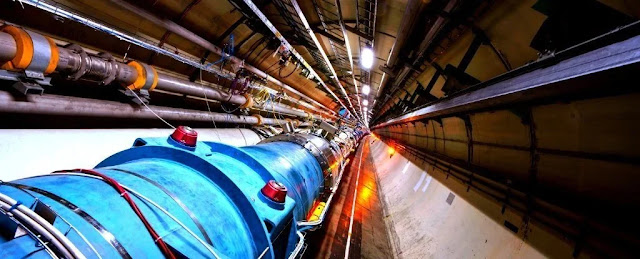 |
The LHC in 2018. (Maximilien Brice/Julien Marius
Ordan/CERN) |
Ten years after it discovered the Higgs boson, the Large Hadron Collider is about to start smashing protons together at unprecedented energy levels in its quest to reveal more secrets about how the universe works.
The world's largest and most powerful particle
collider started back up in April after a three-year break for upgrades in
preparation for its third run.
From Tuesday it will run around the clock for nearly
four years at a record energy of 13.6 trillion electronvolts, the European
Organisation for Nuclear Research (CERN) announced at a press briefing lastweek.
It will send two beams of protons – particles in the
nucleus of an atom – in opposite directions at nearly the speed of light around
a 27-kilometre (17-mile) ring buried 100 meters under the Swiss-French border.
The resulting collisions will be recorded and analyzed
by thousands of scientists as part of a raft of experiments, including ATLAS,
CMS, ALICE and LHCb, which will use the enhanced power to probe dark matter,
dark energy and other fundamental mysteries.
1.6 billion collisions a second
"We aim to be delivering 1.6 billion
proton-proton collisions per second" for the ATLAS and CMS experiments,
CERN's head of accelerators and technology Mike Lamont said.
This time around the proton beams will be narrowed to
less than 10 microns – a human hair is around 70 microns thick – to increase
the collision rate, he added.
The new energy rate will allow them to further
investigate the Higgs boson, which the Large Hadron Collider first observed on
4 July 2012.
The discovery revolutionized physics in part because
the boson fit within the Standard Model – the mainstream theory of all the
fundamental particles that make up matter and the forces that govern them.
However several recent findings have raised questions
about the Standard Model, and the newly upgraded collider will look at the
Higgs boson in more depth.
"The Higgs boson is related to some of the most
profound open questions in fundamental physics today," said CERN
director-general Fabiola Gianotti, who first announced the boson's discovery a
decade ago.
Compared to the collider's first run that discovered
the boson, this time around there will be 20 times more collisions.
"This is a significant increase, paving the way
for new discoveries," Lamont said.
Joachim Mnich, CERN's head of research and computing,
said there was still much more to learn about the boson.
"Is the Higgs boson really a fundamental particle
or is it a composite?" he asked.
"Is it the only Higgs-like particle that exists –
or are there others?"
'New physics season'
Past experiments have determined the mass of the Higgs
boson, as well as more than 60 composite particles predicted by the Standard
Model, such as the tetraquark.
But Gian Giudice, head of CERN's theoretical physics department,
said observing particles is only part of the job.
"Particle physics does not simply want to
understand the how – our goal is to understand the why," he said.
Among the Large Hadron Collider's nine experiments is
ALICE, which probes the matter that existed in the first 10 microseconds after
the Big Bang, and LHCf, which uses the collisions to simulate cosmic rays.
After this run, the collider will come back in 2029 as
the High-Luminosity LHC, increasing the number of detectable events by a factor
of 10.
Beyond that, the scientists are planning a Future
Circular Collider – a 100-kilometre ring that aims to reach energies of a
whopping 100 trillion electronvolts.
But for now, physicists are keenly awaiting results
from the Large Hadron Collider's third run.
"A new physics season is starting," CERNsaid.




0 Comments